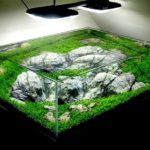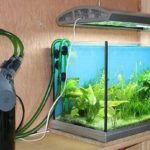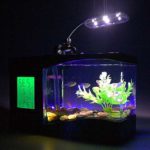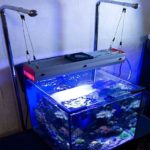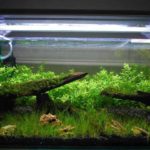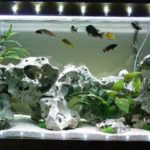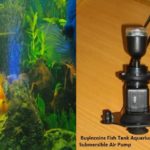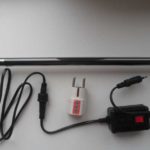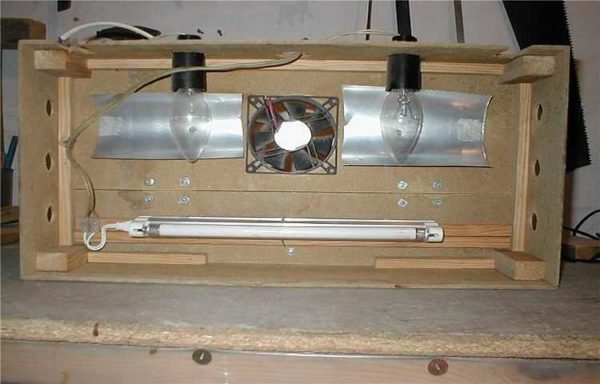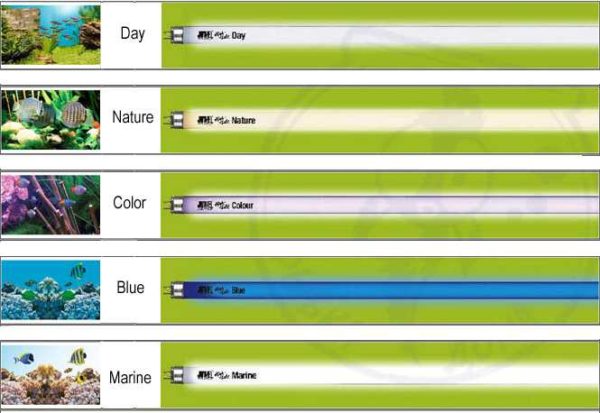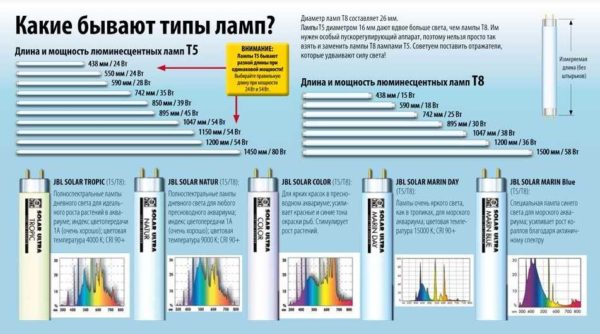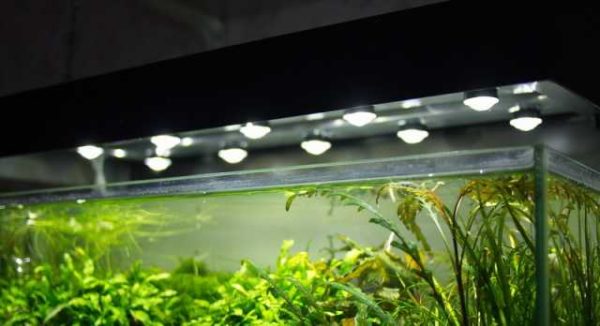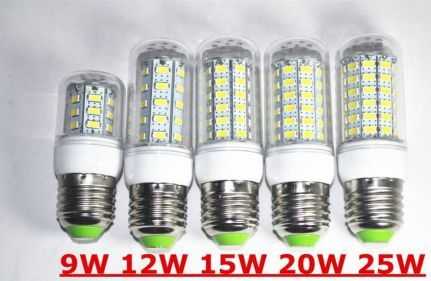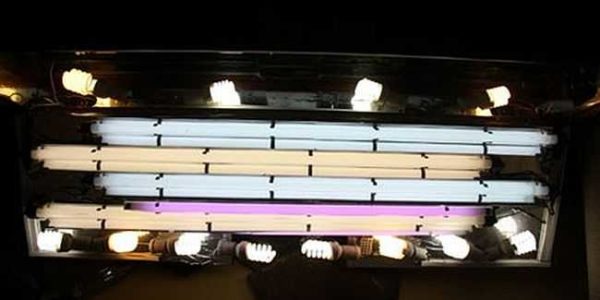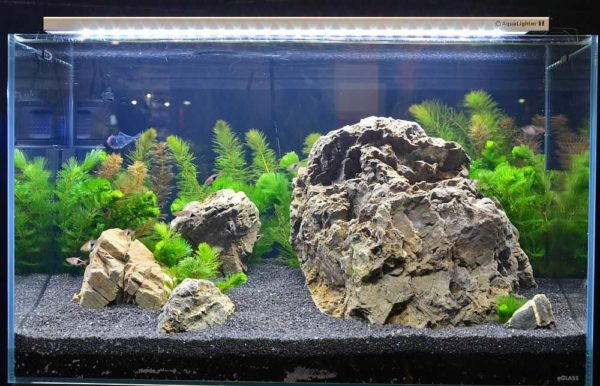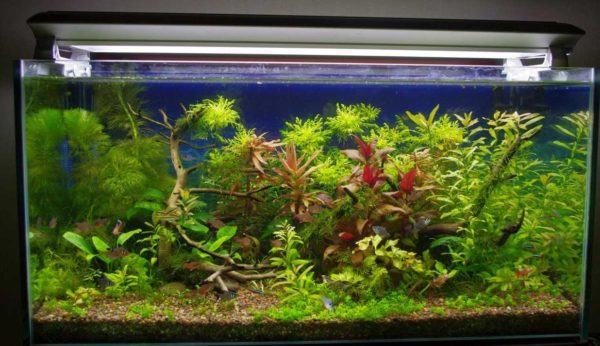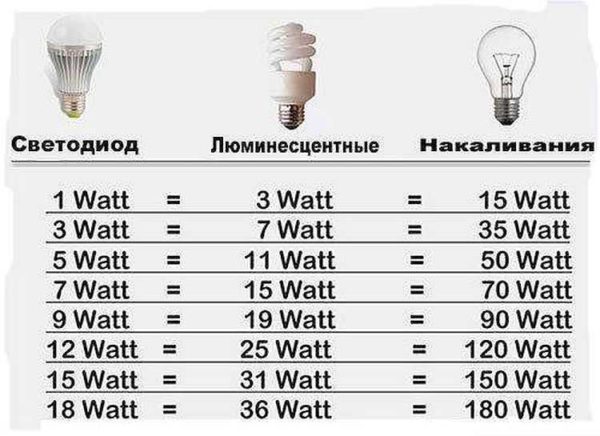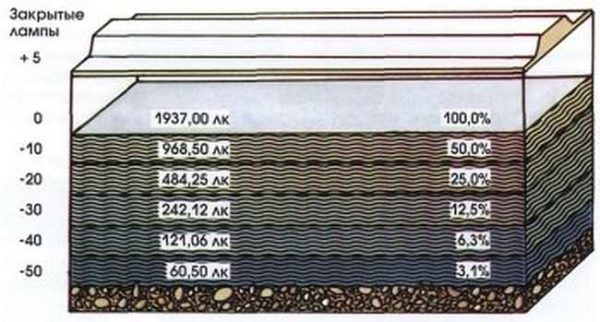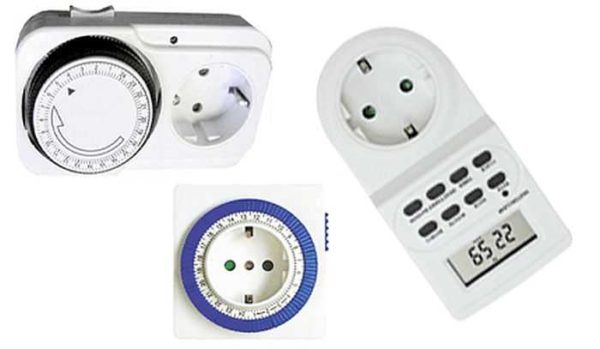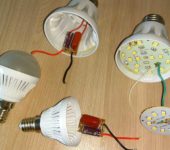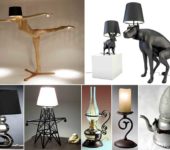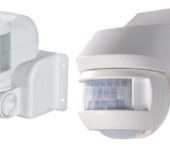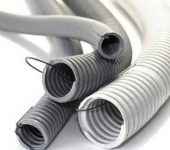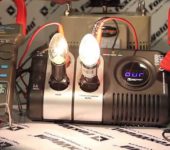How to make light in an aquarium
Aquarium plants need a lot of light for normal growth and development. Fish do not need it so much, but with sufficient light they look very attractive, bright, and behave actively. Therefore, it is so important to choose the right lighting for the aquarium. This is not as easy as it seems at first glance, as there are many details that need to be known.
The content of the article
Where to place the lighting for the aquarium
Most often, the lighting in the aquarium is located on top. The most common option is in the lid. Both long and regular lamps can be installed here. To achieve more uniform illumination, reflectors are installed near the lamps, which redirect and diffuse the light. This is especially important if one long lamp is used. If it is simply attached to the lid, most of the bottom remains in the shade, which is not always a good thing.
But not always being close to the water is a blessing. If you use lamps that generate a lot of heat, you have to install coolers (fans) or raise them above the aquarium. In this case, hangers and stops can be used. Here who will adapt how - there are different options.
- Hang the lamps on a rod
- Make a special mount to the ceiling
- Use clothespin lamps that can be fixed to the sides of the aquarium
- Create a dedicated suspension system
- Use a special lamp on the stops (or make them yourself)
The overhead light does not always reach the bottom in the right amount. Then you can either increase the power of the lamps, or place several on the walls, closer to the bottom or at the very bottom. The latter option is more decorative in nature, but can slightly improve the low illumination in the lower layers.
- LEDs can be positioned both at the bottom and at the top
- Backlit aerator - one option
- Aquarium light with suction cups - can be attached to the walls at any level
More correct is the "overhead" lighting for the aquarium, but to correct the situation and the impossibility of a quick alteration, you can use the light sources located below, or you can install spotlights for a decorative effect - to emphasize some part of the relief or an unusual plant at dusk.
Lamp types
Aquarium lighting can be made with any type of lamp. Anyone in general. But its effectiveness, the appearance of plants and fish, the amount of energy expended will be very different. Let's evaluate from this point of view all types of lamps.
Incandescent and halogen lamps
They are grouped into one category as they have similar advantages and disadvantages. Incandescent bulbs are good for aquariums because they emit light with a spectrum very similar to sunlight. The second big plus is the affordable price. But the disadvantages are very serious. This is a low efficiency - about 97% of the energy is spent on heat generation and only 3% directly on the emission of light waves.
The bills for this kind of aquarium lighting will be decent. In addition, you have to remove the heat that incandescent lamps emit during operation. This is usually done by installing coolers - low-power fans, but they also do not always save.
Metal-halogen
This type of lamp is ideal for aquariums with a lot of grass and if the water column is more than 60 cm. This is due to the wide spectrum of light emitted, its high brightness and the ability to penetrate to great depths. When illuminated by metal-halogen lamps (MGL) at the bottom there will be "sun" glare, shadows from plants and fish.
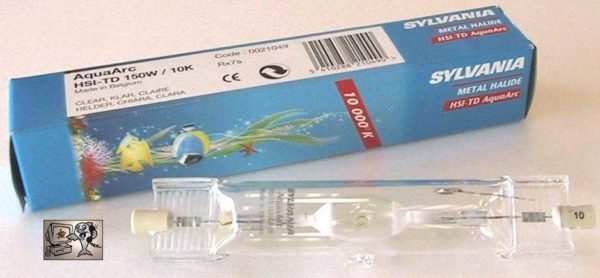
This is what a metal-halogen lamp looks like. Holders are placed on the lid, into which the contacts are inserted
The disadvantage is that during operation they get very hot, so basically such lamps are installed at a distance of at least 30 cm from the water mirror.
Fluorescent lamps
Today these lamps are available in several versions. There are ordinary household (NO). They have a low level of glow, they can be used to illuminate shallow aquariums - up to 50 cm deep. Below the light just won't reach. There are two other technologies HO (High Output) and VHO (Very High Output), which shine many times brighter with the same dimensions. Here their light is able to penetrate to a rather great depth.
In the aquarium, two types of fluorescent lamps are commonly used - T5 and T8. T8 is used more often. They have the best value for money. T5 lamps with a smaller diameter (16 mm versus 26 mm) give twice as much light, but they also cost twice as much as T8. And since they still need to be changed in the same period, the G8 is used more often.
One more point: these two types of lamps are not interchangeable: a special starting-regulating device is required under T5, so the lamps for them are different.
The disadvantage of fluorescent lamps is that over time they "burn out", that is, they change the glow spectrum. This necessitates a replacement every 6-10 months, although the lamp is still working and may continue for many months. But the plants no longer "like" its light. And these are additional costs and quite tangible ones.
Compact fluorescent lamps or housekeepers
In terms of their characteristics, they are very similar to ordinary fluorescent ones, only the shape of the light tube is changed - they are twisted into a spiral - and the cartridge is for standard connectors.
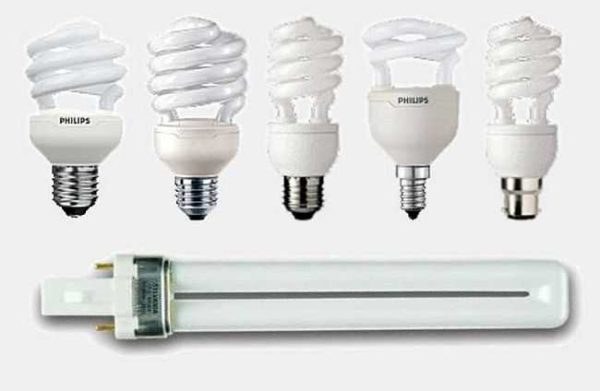
Compact fluorescent lamps can be used instead of household tubular lamps, but there are no special ones
LED
Today, LED lighting for aquariums is considered by many to be optimal. They heat up a little, they shine brightly with low electricity consumption, have a wide color range, and have a long service life. In addition, they are safe as they operate on 12V.
Another plus of using LEDs is that their brightness can be easily changed. In the absence of experience, it is almost impossible to immediately find the optimal amount of light, so the ability to adjust the amount of light is very useful.
The disadvantage of LEDs is the high price for good quality crystals. The second unpleasant moment - they also emit heat, which must be removed. But the heat is generated by the body of the LED and it is easier to dissipate it - to install it on an aluminum plate that will take away the heat. If necessary, you can build in a cooler from the back or raise it higher above the water.
If we speak in relation to the aquarium hobby, then by organizing the correct LED lighting for the aquarium, you can achieve a play of glare and shadows at the bottom, an excellent type of plants and fish.
A few words about what LED lamps are:
- Separate LEDs with different wattage. Usually on sale there are 1 W and 3 W. The brighter, of course, three watt ones, they are usually used, since they are more economical.
- LED strips. It is difficult to find enough LED strip power to be used to illuminate your aquarium. They are there, but they are expensive. But installation is many times easier than with single light sources.
- In the form of an ordinary lamp - a pear-shaped plastic shade with a standard base. There is a subspecies - "corn". Several LEDs are assembled into a single luminaire. They are convenient in that they can be installed in ordinary 220 V lamps, since the voltage converter is located in the holder. The light is bright, only the back of the bulb heats up, and several times less than that of the "Ilyich's bulb".
- Long tubular. These luminaires are very similar to those in which conventional fluorescent lamps are used, but they are smaller because the light sources themselves are smaller in diameter.
For all these reasons, LED aquarium lighting is becoming more and more popular. At low costs during the operation stage, they give good light, "burn out" much more slowly. Moreover, it is possible to make the backlight "colored" using RCD diodes. By the way, they allow you to adjust the amount of a particular "shade" of light.
Combined lighting for aquarium
When designing aquarium lighting, many experienced owners combine several types of lamps - two or even three. In this way, you can achieve optimal illumination at minimum costs. Most often, fluorescent and LED lamps, fluorescent with metal-halogen lamps are combined, all three types are used.
It just seems that the options are few. In fact, there are a lot, since light sources are also selected according to the temperature of the light. As a result, the visual perception and colors of vegetation and fish change decently. When choosing, it is desirable to obtain a spectrum close to the spectrum of sunlight or to choose a combination that is pleasant to all the inhabitants of the aquarium.
Light intensity
To choose the right lighting for an aquarium, you need to take into account many factors: its type (sea or freshwater), the presence of plants in it and their needs (what intensity of light they need), the geometric parameters of the jar itself (the height of the water column) and the color of the water. Depending on all these factors, lamps and lamps are selected.
Selection by volume
A common practice is to adjust the brightness of the aquarium lights based on the volume of the aquarium. The technique does not take into account a lot of nuances, but it can be used as a basis - to roughly determine the required lamp power. The required power of the lamps is calculated depending on the volume of water (not the reservoir, but water - subtract the air gap and the thickness of the soil).
- For an aquarium without plants, not much light is needed - fish do not need much. It is counted at 0.1-0.3 W / l.
- If the aquarium contains shade-loving algae and fish, the lighting power can be calculated based on the norm of 0.2-0.4 W / L.
- Average illumination - 0.4-0.5 W / l. But with this choice, the plants will grow slowly, they will stretch upward.
- Optimal illumination for a normal herbalist, for bright and healthy plants is 0.5-0.8 W / l.
- Bright illumination with a large number of light-loving plants - 0.8-1.0 W / l.
The data are given for lighting with incandescent lamps and halogen lamps. But today they are used less and less, since they are ineffective and get very hot. You can determine the required power of other light sources according to the correspondence table.
After calculating how much fluorescent lamp power you need, you can calculate the required power of other types of light sources.
Depth selection
When determining the light intensity of an aquarium, its depth must be considered. The thing is that when 10 cm of water of medium transparency passes through, the illumination drops by 50%.
This means that if the illumination on the surface is 1000 lm, at a depth of 60 cm it will only reach about 15 lm, and below it will be practically dark. If you want to have healthy plants, you need to have at least 60-90 lm at the bottom of the light. Therefore, when calculating the lighting intensity for an aquarium, its depth should also be taken into account.
Aquarium lighting time
When designing lighting, the question arises: how long should the aquarium lighting last. The answer is based on the "habits" of plants and fish. They are native to tropical latitudes, and there the daylight hours lasts about 12 hours, regardless of the season. This is the kind of lighting you need to provide your plants.
Sometimes they try to compensate for the lack of illumination by extending the daylight hours. This usually does not have positive consequences, but negative ones appear very often - with a long daylight hours, the water begins to bloom, the illumination even decreases, and it becomes necessary to replace the water.
In addition to the fact that the light in the aquarium should burn for a certain time, it is desirable to create some kind of half a day - some time - 3-4 hours a day - the lighting should be very bright, the rest of the time the intensity of the aquarium lighting can be reduced. To implement such a mode, several lamps are used, which are switched on through separate toggle switches / switches.
In order to automate the process, you can install a time relay. Today there are absolutely inexpensive models through which lamps can be turned on. They are mechanical and electronic. Electronic ones can be programmable and you do not have to set the time every time, since the power will be supplied and turned off automatically.


